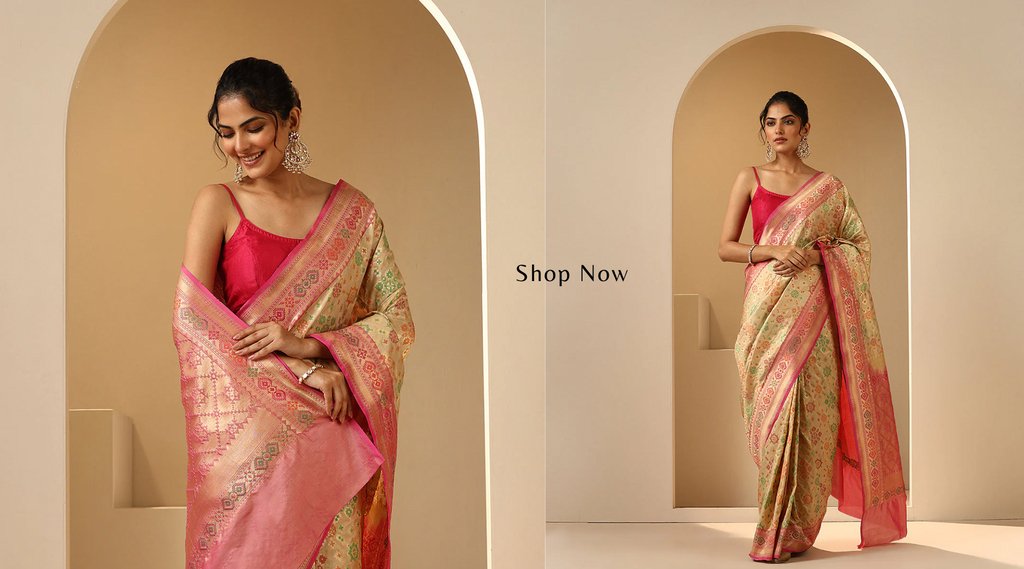From the dextrous process involved in making every single saree to how the 12th-century weave finds relevance even today, we are shedding light on what is christened as the Queen of Silks - the Patola sarees. While fashion trends may come and go, what stays untouched and timeless is the age-old handloom techniques. As the ingenious and intricate techniques involved in Indian weaving are gradually being given the credit that they deserve, we couldn’t help but talk about what makes the extraordinary Patola silk sarees, an heirloom buy.
The origin:
The name ‘patola’ originates from the Sanskrit word ‘pattakulla’ and is the plural form of the word patolu. Even though the patola print is considered to have originated from Gujarat, it finds its earliest mentions in the South Indian religious text - Narasimha Purana, which talks about this gorgeous fabric being donned by women during holy ceremonies. While there are several theories when it comes to the first appearance of the patola sarees. One of the most popular folktales claims that patola originated 900 years ago. King Kumarpala was an ardent admirer of the weave and soon made it a status symbol. The patola was a privilege only aristocrats could afford because of the invaluable technique and immense amount of time involved in the making process. King Kumarpala’s patola supply came from Jalna in Maharashtra.
However, after learning that the King of Jalna would pass on the patola to aristocrats only after using it as bedsheets, King Kumarpala brought 700 patola craftsmen and their families from Maharashtra and Karnataka to Patan, Gujarat. And that’s how the Patan Patola finds its origin. If the story is to be believed, it is said that King Kumarpala staggered the production of the patola fabric, and even though each garment went through a seven-month-long process, he still had a new Patola to wear every day to the temple. Electric Blue And Mustard Double Shade Handloom Pure Mulberry Silk Ikat Patola Saree is perfect for all your auspicious occasions. Just like the origin revives the history draping the alluring handcrafted luxury.
The Technique:
Padi Patole bhaat, phate pan fittey nahi - A Gujarati phrase which means that the cloth of the Patola may tear over the years, but the colour and design will never fade. A double-ikat woven saree, the Patola is made exclusively in Gujarat’s Patan town and is literally a work of art that is passed down through generations. The double-ikat means that once the saree is made, one cannot distinguish between the two sides. Everything, from the colour, intensity and pattern is the same on both sides.
Many consider the Patola saree ‘the ultimate manifestation of weaving perfection’ because even a single thread’s displacement can completely deform the pattern, making the piece redundant. The weaving of every Patola saree requires a great deal of mathematical precision, a vivid quality of visualisation of the final product and extreme patience.
Patolas are manufactured by the resist-dyeing process using the warp and weft technique. It usually involves the work of three artisans working on every saree for about four-seven months, making it expensive and time-consuming. The time taken to make a single saree depends on the length and intricacy of the pattern. The measurements involved in the weaving technique can be as small as 1/100th of an inch. The yarn undergoes multiple cycles of tying and dyeing, following a specific order of colours. The Handloom Mustard Pure Mulberry Silk Single Ikat Patola Saree With Rani Tissue Broad Border is the perfect artistry and a must-have in your wardrobe.
The different designs of a Patola:
Patolas are iconic and can be easily identified from a distance owing to their abstract design and geometric patterns. You will find elephants, human figures, kalash, paan and parrots, and designs inspired by Gujarat’s beautiful architecture. The most popular designs each have names given to them for easy identification: nari kunjar bhat (women & elephant patterns), paan bhat (peepul leaf motif), navratna Bhat (square-shaped pattern) and fulvali bhat (floral).
Natural dyes like indigo, turmeric, natural lakh, Katha, madder roots, cochineal, pomegranate skin, henna and marigold lend extraordinary shades that these sarees boast. The reversible design and the unfading shades are what make this gorgeous saree unique and worthy of every onlooker’s awe.
WeaverStory’s Patola Collection:
At WeaverStory, we are consistently working on drawing attention to the hard work of each weaver and artisan involved in the process of weaving. When it comes to the Patola sarees, you can find a range of Ikat Patola Sarees that will win your heart and soul. The intricacy and detailing of each saree are what make you appreciate the craft even more. Explore the various options available in the Patola Sarees from Gujarat collection as well as the Banarasi Patola Sarees collection and get your hands on authentic Patolas that are worked on by talented artisans. The banarasi patola is a next-level luxury defined intricately. Handloom Offwhite Pure Katan Silk Banarasi Patola Saree With Pink Border is a perfect example of banarasi handloom.
Buying a Patola saree is an investment that you will cherish for years to come and it is important to realise that the worth of a Patola saree is much greater than just the price tag attached to it.
Author: Niti Desai









